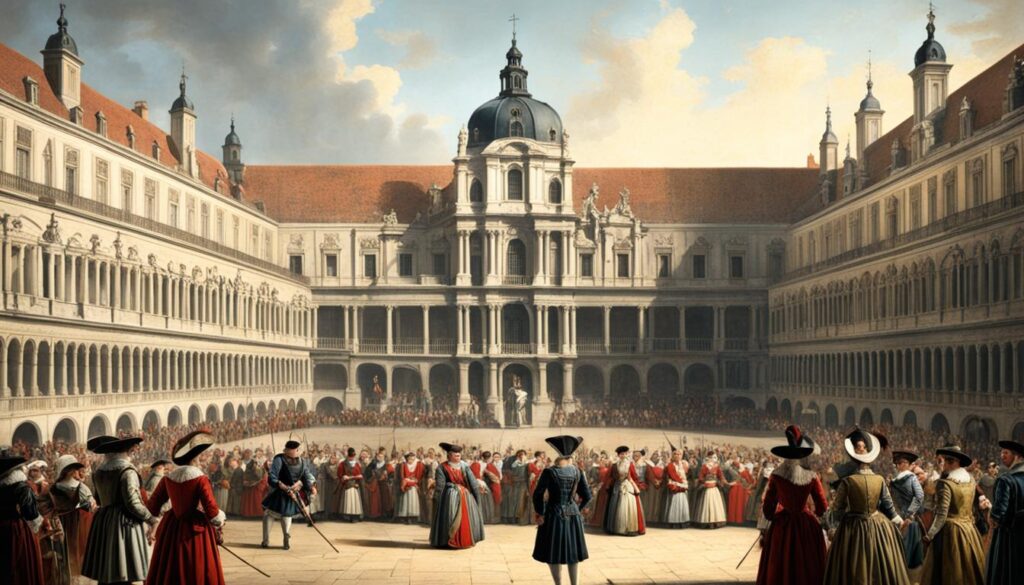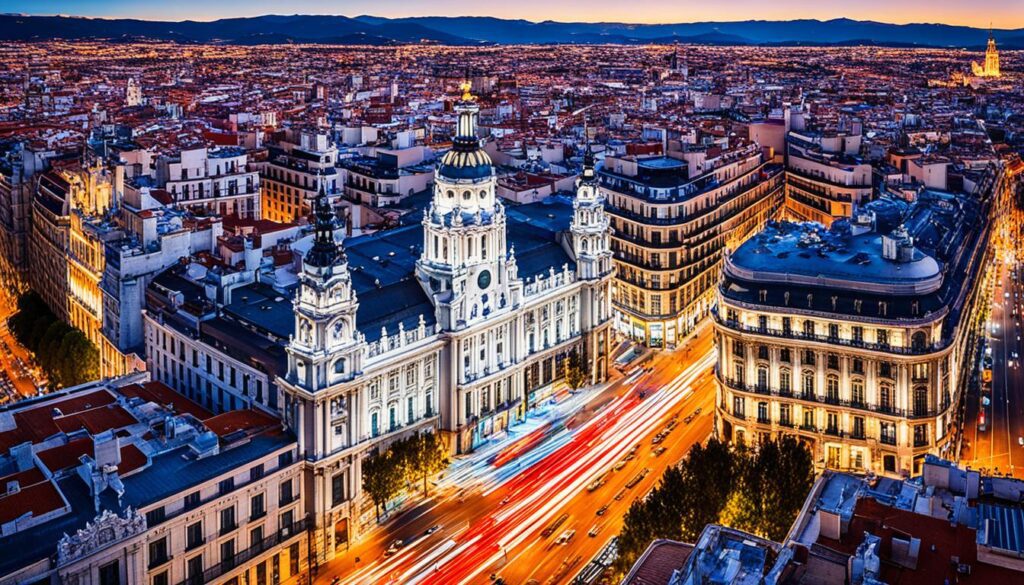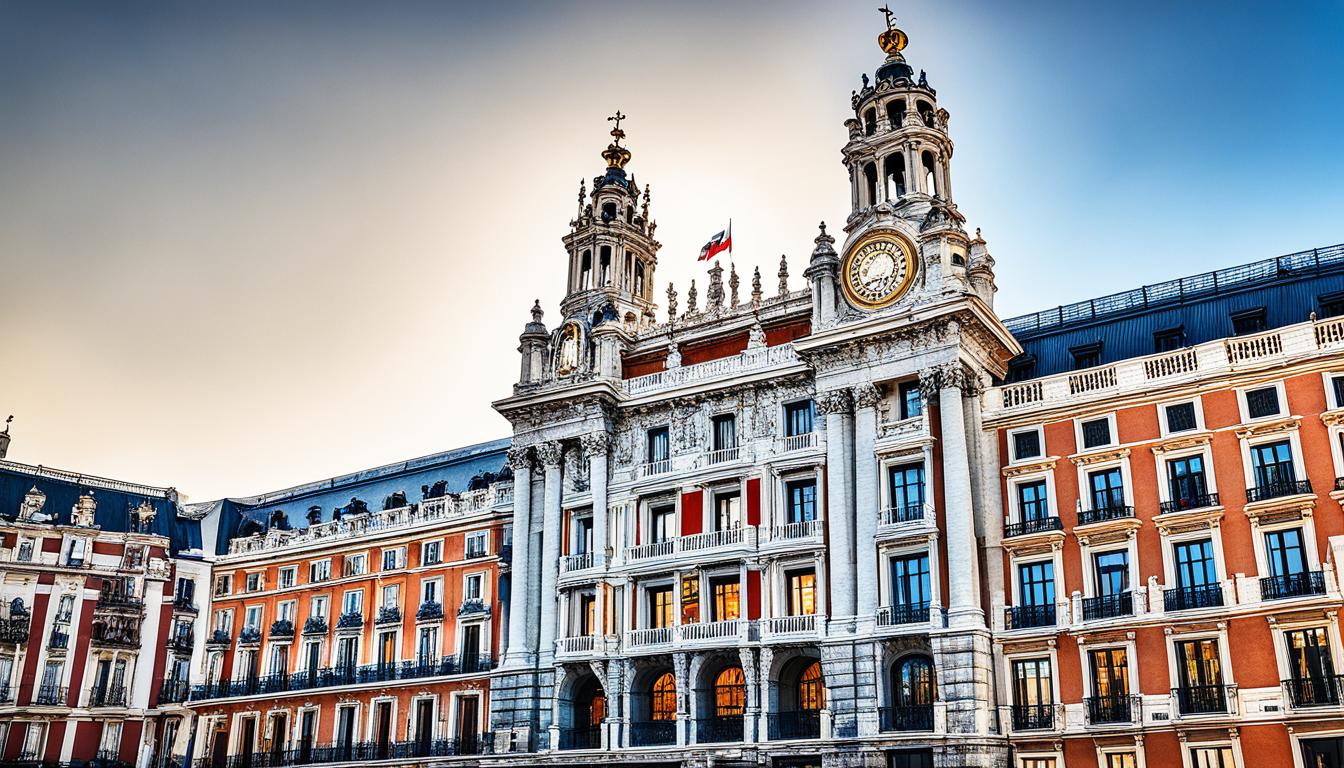Madrid calls out to visitors from all over the world. It offers a peek into the past and the chance for unforgettable moments. The city blends history, culture, and modern life perfectly. This makes it a top spot for those wanting to dive into European history and culture.
Madrid is full of landmarks, museums, and art. Its lively plazas and culture are a treat for anyone. It’s a place where history and the present come together beautifully.
Key Takeaways
- Madrid is home to dozens of remarkable historical monuments and sites, reflecting its rich cultural heritage.
- Many of Madrid’s historic landmarks were built after the city became the capital of Spain and evolved into a world-class metropolitan area.
- Iconic sites like the Basilica de San Francisco El Grande, the Temple of Debod, and Puerta del Sol showcase Madrid’s diverse architectural and artistic legacies.
- Renowned public spaces such as Plaza Mayor, Plaza de Cibeles, and Retiro Park offer visitors a chance to immerse themselves in Madrid’s vibrant history and contemporary charm.
- Madrid’s central transportation hub, Atocha Station, has been revamped to accommodate modern travel while preserving its historic character.
Prehistoric Roots: Madrid’s Earliest Inhabitants
Madrid’s history goes way back, even before the 9th century. The area’s prehistoric roots are quite fascinating. Archaeologists have found ancient tools and the remains of big animals by the Manzanares River. These discoveries show us that prehistoric humans lived in the region.
Evidence of Ancient Settlements Along the Manzanares River
The Manzanares River has been key to human life in Madrid for a long time. Archaeologists have found many artifacts by the river. These items tell us about the lives of the first people in Madrid.
The river was crucial for food and travel for these early communities. It helped them survive and thrive.
Unearthed Tools and Remains from Prehistoric Times
- Archaeologists have found axes and other stone tools. This shows that the first people in Madrid used simple technology.
- They also found fossils of big animals like mammoths and bison. This tells us about the wildlife in prehistoric Madrid.
- These discoveries help us understand the daily lives of Madrid’s ancient sites and Madrid’s history.
The prehistoric Madrid heritage is still fascinating today. Historians and archaeologists are always learning more about this time. They help us see how Madrid became the city it is now.
The Founding of Mayrit: Madrid’s Islamic Origins
Madrid, known as Mayrit back then, has a deep Islamic history. It was started around 865 A.D. by Umayyad emir Mohamed I. Mayrit was part of Al-Andalus, a vast area in the Iberian Peninsula ruled by Muslims.
Emir Muhammad’s Establishment of the City in the 9th Century
Emir Muhammad founded Mayrit to protect the area from Christian kingdoms to the north. It became a key center for Islamic culture and learning. It was an important part of the Umayyad empire.
The Flourishing of Madrid During the Arab Occupation
For over two centuries, Madrid was under Arab rule. The Muslim community was key in the city’s politics and culture. The Royal Palace sits where the Moors built their Alcazar in the ninth century, showing Madrid’s Islamic roots.
Even after Madrid was conquered by Christians in 1085, its Islamic influence stayed strong. The Mudéjar architectural style, blending Renaissance and Islamic designs, is seen in many old buildings. This style keeps the memory of Madrid’s Muslim past alive.
Today, groups like the Centre for the Study of Islamic Madrid (CEMI) and the Spain’s Islamic Culture Foundation (FUNCI) help keep Madrid’s Islamic heritage alive. They make sure this important part of the city’s story is known and honored.
“Embracing Madrid’s multi-cultural heritage is crucial to promoting inclusiveness and peaceful coexistence in the present,” emphasizes Encarna Gutierrez from the Islamic Culture Foundation.
Madrid’s Islamic roots are still a big part of its identity today. They influence its architecture, culture, and the lives of its people. Recognizing and celebrating this history helps us understand Madrid’s past and its future.
Madrid’s Central Location: Strategic Vision of King Alfonso I
In Madrid history, King Alfonso I played a key role. He made the city a central spot in Spain in 1083. This move changed the city’s future.
Before King Alfonso, Madrid was under Muslim rule. The city had many signs of Islamic culture. But, the king’s plan to put the city in the middle changed everything. It started a new era of Spanish rule and made Madrid a key place of power.
Madrid’s central location is very important. It sits high, about 2,120 feet above sea level. This spot gave a great view of the area. Plus, it was close to the Manzanares River, making it a perfect spot for controlling the region.
King Alfonso’s leadership changed Madrid for the better. His vision helped the city grow and develop over time. Now, Madrid is a lively center of Spanish culture, history, and politics.
Madrid historical sites: The Court of Madrid and the Spanish Inquisition
Madrid’s history is filled with key events that have shaped the city. One major event was when King Fernando V set up the Court of Madrid in 1329. This event led to a dark period in Spanish history – the Spanish Inquisition.
King Fernando V’s Establishment of the Renowned Court
King Fernando V made Madrid a key center of power with the Court of Madrid in 1329. This move made the city more important as a political and administrative center. The court drew nobles, scholars, and influential people, making Madrid a center of culture and learning.
The Darker Chapter of the Spanish Inquisition
The Court of Madrid also led to the Spanish Inquisition, a time of religious persecution. King Fernando V and Queen Isabella I started the Inquisition to target those who practiced Judaism or Islam. This led to the expulsion and persecution of many Moors and Jews from Madrid and Spain.
The Inquisition deeply affected Madrid’s historical sites and culture. Many religious buildings and symbols were destroyed or changed, wiping out the city’s multicultural past.

Even with the dark period of the Spanish Inquisition, Madrid’s historical sites still tell the city’s complex story. Visitors can see the grand plazas, beautiful architecture, and cultural spots. They learn about a city that has been at the center of Spain’s history for a long time.
Moreria: A Haven for Moors and Jews
After the Reconquista, Madrid became a safe place for Moors and Jews who had lived there before. They formed a community called Moreria. Here, they kept their traditions and ways of life. But, this peace didn’t last long.
The Concentrated Community of Moors and Jews in Madrid
Moreria was a neighborhood in Madrid where many Moors and Jews lived. It showed the city’s rich cultural mix. These people lived together, keeping their customs alive. They were known for their skills in art, trade, and learning, enriching Madrid’s culture and knowledge.
The Expulsion and Destruction of Their Cultural Symbols
In 1494, the Moors and Jews were called “unbelievers” and forced out of Spain. This was a dark time for Madrid, as its mosques and cultural symbols were destroyed. The loss of Moreria’s culture was huge, showing how fragile peace and acceptance can be.
Madrid’s history is complex, with the stories of Moors and Jews still part of the city. Though Moreria is gone, its spirit lives on. It teaches us the value of diversity and keeping our heritage alive, making Madrid the lively place it is today.
The War of Independence: Madrid’s Struggle for Freedom
On May 2nd, 1808, the people of Madrid stood up at the Puerta del Sol. This started the Madrid War of Independence. The Spanish fought against Napoleon and their former allies. Madrid’s patriotic memorials, like Plaza Dos de Mayo, remind us of this hard time.
The Revolt at Puerta del Sol and the War Against Napoleon
The Madrid resistance started with a sudden uprising at Puerta del Sol. Citizens showed bravery against the French. This led to a big revolt across the country, starting the Madrid War of Independence.
For years, the Spanish fought hard against Napoleon’s army. The Duke of Wellington’s wins at Talavera and Vitoria were key in defeating the French.
Patriotic Memorials Commemorating Madrid’s Resistance
Now, Madrid memorials honor the city’s strong spirit during the War of Independence. The Plaza Dos de Mayo has a moving monument. It remembers the brave Madrileños who gave their lives for freedom.
These sites do more than just remember the past. They also motivate future generations to keep the values of courage and self-determination alive.
“The people of Madrid showed an indomitable spirit in the face of adversity, inspiring the nation to rise up and reclaim its independence.”
The Birth of Universidad Complutense de Madrid
In 1835, Madrid’s education scene changed forever when the University of Alcala de Henares moved to the capital. This famous school, started in 1293, added a Science Faculty. This move made it a top place for learning.
Now known as the Universidad Complutense de Madrid (UCM), it’s a top university in Spain. It has over 86,000 students, making it one of Europe’s biggest universities. The UCM offers many programs across various faculties.
The Relocation of the University of Alcala de Henares
The Universidad Complutense de Madrid started as the University of Alcala de Henares in 1293. It moved to Madrid in 1836, bringing its long history and dedication to learning.
Moving to Madrid was smart, given the city’s central location and growing importance. This move let the university grow, adding a Science Faculty. This joined Theology, Medicine, and Jurisprudence programs.
The Expansion of Educational Offerings with a Faculty of Science
The Universidad Complutense de Madrid quickly became a center for new ideas and discoveries. With the Science Faculty, it could offer more courses and attract scholars from all over.
- By 1508, the university taught subjects like moral philosophy, Theology, Canon Law, and Liberal Arts.
- In 1510, Medicine became a key subject, showing its value to the community’s health.
- Over time, the UCM has given out many important degrees. This includes the first doctorate in Spain in 1857 and the first to a woman in 1785.
Today, the Universidad Complutense de Madrid shows the lasting impact of Spain’s education. It’s a leading university, shaping students’ futures and advancing knowledge in many fields.
Modern Madrid: A City Transformed
Modern Madrid has grown into a leading city in Europe, known for its vibrant culture and rich history. It’s a place where art, nightlife, and heritage come together. Travelers looking for the essence of European culture find Madrid a perfect spot.
Madrid’s Thriving Arts Scene and Vibrant Nightlife
Madrid is a center for art, filled with museums, galleries, and places for performances. The Golden Triangle of Art is famous for its art from Velázquez, Goya, and Picasso. It shows Spain’s deep artistic roots.
The city’s nightlife is just as exciting. From the busy tapas bars at Plaza Mayor to the trendy clubs on Gran Vía, Madrid is alive with energy. It’s a place where local culture meets global visitors.
The Harmonious Blend of History and Modernity
Madrid keeps its history alive while looking to the future. Its buildings show a mix of old and new styles. The Palacio Real, Almudena Cathedral, and Puerta de Alcalá stand alongside modern structures. This mix makes the city’s look unique.
Madrid is changing but still values its heritage. It’s a place where you can enjoy the modern Madrid vibe, its thriving arts scene, and vibrant nightlife. It also has a harmonious blend of history and modernity.

Conclusion
Madrid’s story is full of resilience, cultural exchange, and change. From ancient times to today, it shows the strength of its people and their ability to change. By visiting places like the Royal Palace, the Prado Museum, and the Almudena Cathedral, you can dive into Madrid’s deep history. You’ll see how history and modern life mix in this lively city.
Madrid has seen many important events, like the Spanish Inquisition, the War of Independence, and the Second Republic. These events have shaped the city and left a lasting mark. By exploring Madrid’s historical sites, you learn about its growth and its role as a cultural and artistic center.
Visiting Madrid’s historical sites is a must for anyone wanting to discover the city’s true spirit. Whether you’re interested in architecture, museums, or public spaces, you’ll be amazed. As you walk through Madrid, you’ll feel like you’re traveling back in time. The city’s mix of past and present makes for an unforgettable experience.

